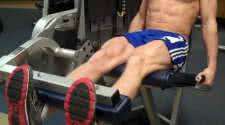Proper Muscle Exercises Instructions: Leg Extensions

Proper Form with Muscular Exercises for Development
Over the past year with fitFLEX, we've tried to make the point that although bodybuilding and strength training have been around for a longtime, there's always something new to discover if you look hard enough. Who'd have thought that situps would be making a comeback after all
these years? As I discussed in my recent columns on ab training, that's exactly what's happening. On that score the Abs Mat is having an unprecedented effect on abdominal training.
Another running theme here is that most of the best innovations actually originate with in-the- trenches bodybuilders, not the scientists and engineers who get the credit. Were always looking to the equipment companies with their money and their high-tech engineers to keep us at
the forefront of muscle-building technology, but what usually happens is, some muscle head comes up with a good movement for working a specific muscle. Not knowing the value of what he's found, he displays typical enthusiasm, sharing his idea with everyone. Some equipment company
gets wind of it and translates it into a new piece of equipment, which causes all the other companies to jump on the bandwagon, putting out their own versions. Once again, it's all based on information that came from the bodybuilding world.
This is one of those ideas. With all that has been written about leg extensions over the years, who would have believed there was more to say? As it turns out, not only have the equipment companies, with all their engineers, missed the boat on this one, but strength coaches,
scientists and even bodybuilders have too.
The Leg Extension: A Rethinking
Here's a question that's so obvious, no one has ever addressed it before: Why would you do leg extensions in a seated position? Is that the most efficient way to work the thigh muscles? No way. In fact, the point is, the seated leg extension was developed for knee rehab. Now, when bodybuilders do leg extensions, they're not looking for rehab; they're looking to increase the sweep of their outer quads and carve definition into the quadriceps group. Most of the time when you use your quadriceps in daily life, as opposed to in the gym, you use them while standing up. You don't bend over when you stand or run, why would that be the best way to exercise the leg muscles?When your torso is at a right angle to your legs, as it is during the traditional leg press, the rectus femoris is slack, and the other quadriceps muscles are not at their tightest either. That's not the case when your torso is straight. So think of how much more you'd get out of a set of leg extensions if you could perform them while lying back on the bench.
When you do your leg extensions that way, the rectus femoris is stretched out at the hip, which causes the vastus lateralis, vastus medialis and vastus intermedius to be further tightened due to the pressure put on them. The focus of the contraction moves from the knee area up to the middle of the thigh, at the center of the muscle belly.
That's where the sweep should be. This point is particularly important for women who compete in fitness, where the goal is often to work the quads higher and avoid developing a bulky lower-quad area. If you're looking for thigh sweep and some serious definition between those muscles, try working leg extensions lying down. I know it's difficult to get into this position on the current leg extension machines, but most bodybuilders never let a little thing like that stop them.
An Amazing little Device
No, I'm not going to hype the Ab Mat again. Just as I started writing this article, I received one of the coolest products for doing front squats that I've ever seen.You know front squats. They're the ones we'd all love to do if the bar didn't dig into our shoulders when we do them. Front squats put the resistance on the front of your torso, put less pressure on your lower back and allow you go deeper than traditional back squats. Unfortunately, the bar always digs into your shoulders-at least it has until now.